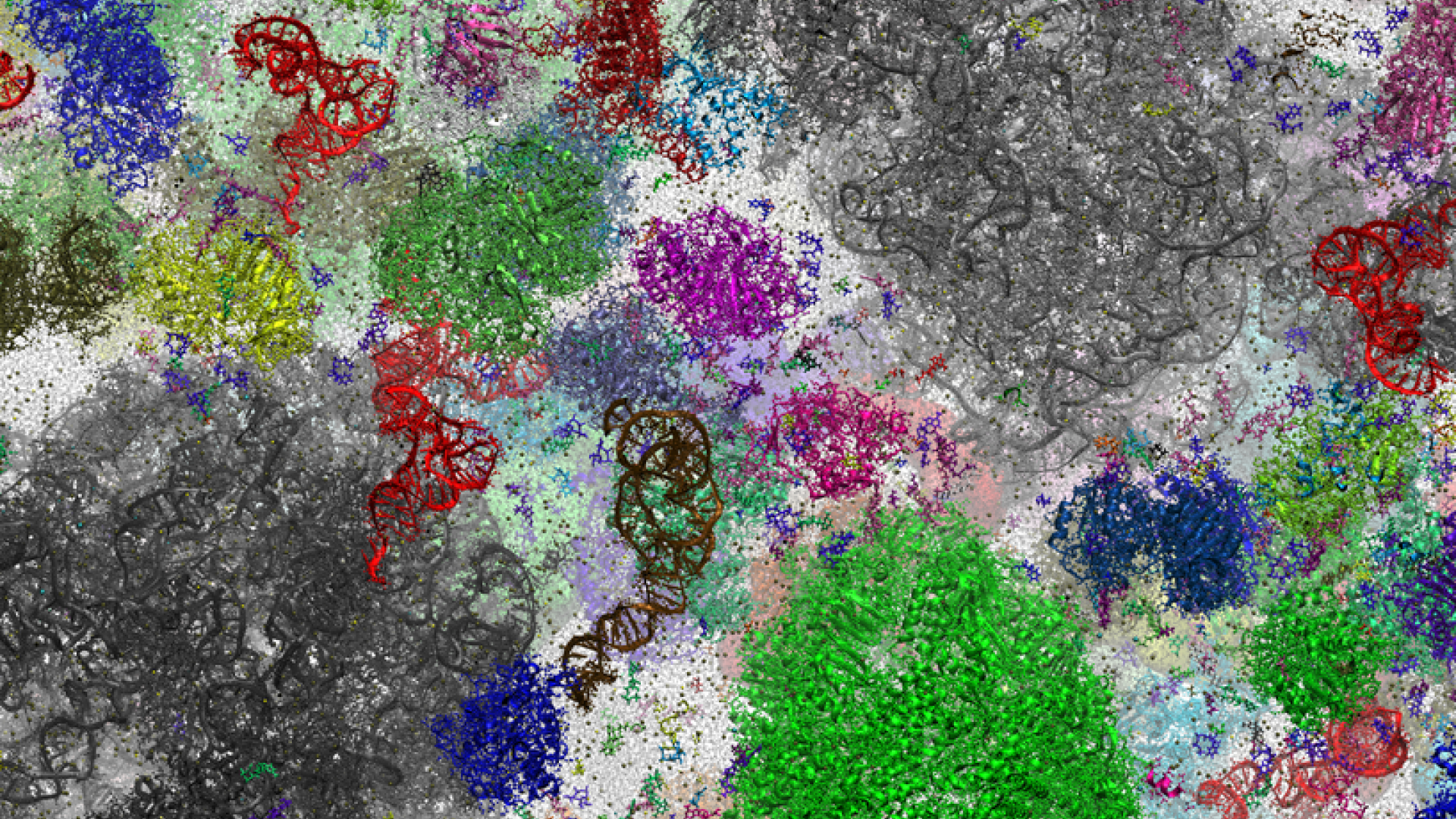Most life forms, including plants, animals, and humans, are composed of cells. The cell itself is a kind of tiny factory where millions of molecules interact continuously to perform the tasks needed to keep life going. Despite the cell’s diminutive size, which is typically on the order of a hundredth of a millimeter, the molecules within it are about 1000 times smaller. These molecules exhibit rapid, constant motion, with each one executing billions (!) of twists and turns per second. Remarkably, within this complex dance of millions of molecules, a meaningful and functional cell emerges.
Researchers worldwide are dedicated to unraveling the mystery of how cellular function arises from this seemingly chaotic whirlwind of motion. To gain insights, they employ the most powerful supercomputers for ”molecular dynamics,” a scientific discipline focused on simulating the movements and interactions of molecules. The underlying concept of molecular dynamics simulations is akin to creating a computational laboratory [3], offering a glimpse into the molecular world in motion within each living organism.
One of the main challenges in molecular dynamics is overcoming the ‘timescale barrier’. This term stands for the fact that the important events are hidden within many insignificant details like a needle in a haystack: They are ”rare”, in the sense that the probability of seeing such an event even in the longest possible simulation is very low [7]. This is true, for example, for socalled ligand-target docking processes, that is, for understanding whether and how a drug deactivates disease-related processes in the cells of a patient. These important rare events occur on timescales that are not accessible to direct simulation, even on the largest or specifically dedicated supercomputers. They lack the speed required for the task, and unfortunately, the anticipated advancements in computing power over the next few decades will still fall short of making them sufficiently fast.
Motivated by this challenge, ZIB researchers have worked hard for many years to overcome the timescale barrier by devising innovative approaches for performing rare event simulations more efficiently [1, 4, 6, 7, 12]. The basic idea is straightforward: glean insights from simulations to identify molecular motions of lesser importance, channeling computational efforts exclusively towards the crucial ones. Although easily articulated, this necessitated the formulation of a novel mathematical theory that enables the development of alternative methods for molecular dynamics, coupled with the training of artificial intelligence to differentiate between insignificant and significant molecular motions [2, 9, 11]. Berlin’s mathematical community, including ZIB’s researchers, spearheaded this groundbreaking development.
In fact, we are now able to simulate important processes like ligand-target docking or protein-protein association with unprecedented accuracy and at much lower computational cost, allowing for important breakthroughs like the design of novel pain relief drugs [8]. Such simulations now require weeks of computing time, a vast improvement compared to the potential decades (!) it would have taken using conventional approaches. While this progress is commendable, a full in-depth understanding of the molecular world in motion within a living organism necessitates another substantial acceleration of our computational methods, cf. [5, 10]. The next formidable challenge is waiting!
References:
[1] A. Bittracher, P. Koltai, S. Klus, R. Banisch, M. Dellnitz, and C. Schütte. Transition manifolds of complex metastable systems: theory and data-driven computation of effective dynamics. Jounal of Non-linear Science 28.2 (2018), 471–512. DOI: 10.1007/s00332-017-9415-0.
[2] A. Bittracher, M. Mollenhauer, P. Koltai, and C. Schütte. Optimal reaction coordinates: Variational characterization and sparse computation. Multiscale Modelling & Simulation 21.2 (2023), 449–488. DOI: 10.1137/ 21M1448367.
[3] H. Ingolfsson, C. Arnarez, X. Periole, and S. Mar-rink. Computational ’microscopy of cellular membranes. Journal of Cell Science 129 (Jan. 2016). DOI: 10.1242/jcs.176040.
[4] M. Mollenhauer, S. Klus, C. Schütte, and P. Koltai. Kernel autocovariance operators of stationary processes: estimation and convergence. Journal of Machine Learning Research 23.327 (2022), 1–34. URL: https://jmlr.org/papers/v23/20-442.html.
[5] A. Montefusco, L. Helfmann, T. Okunola, S. Winkelmann, and C. Schütte. Partial mean-field model for neurotransmission dynamics. Mathematical Bio-sciences 369 (2024). DOI: 10.1016/j.mbs.2024. 109143.
[6] R. J. Rabben, S. Ray, and M. Weber. ISOKANN: in-variant subspaces of Koopman operators learned by a neural network. The Journal of Chemical Physics 153.11 (2020), 114109. DOI: 10.1063/5.0015132.
[7] C. Schütte, S. Klus, and C. Hartmann. Overcoming the timescale barrier in molecular dynamics: transfer operators, variational principles, and machine learning. Acta Numerica 32 (2023), 517–673. DOI: 10.1017/S0962492923000016.
[8] C. Secker, K. Fackeldey, M. Weber, S. Ray, C. Gorgulla, and C. Schütte. Novel multi-objective affinity approach allows to identify pH-specific ?-opioid receptor agonists. Journal of Cheminformatics 15 (2023). DOI: 10.1186/s13321-023-00746-4.
[9] A. Sikorski, E. R. Borrell, and M. Weber. Learning Koopman eigenfunctions of stochastic diffusions with optimal importance sampling and ISOKANN. Journal of Mathematical Physics 65 (2024), 013502. DOI: 10.1063/5.0140764.
[10] A. Thies, V. Sunkara, S. Ray, H. Wulkow, M. Ö. Celik, F. Yergöz, C. Schütte, C. Stein, M. Weber, and S. Winkelmann. Modelling altered signalling of G-protein coupled receptors in inflamed environment to advance drug design. Scientific Reports 13.607 (2023).DOI: 10.1038/s41598-023-27699-w.
[10] W. Zhang and C. Schütte. On finding optimal collective variables for complex systems by minimizing the deviation between effective and full dynamics. 2024. arXiv: 2405.02001 [math.OC].
[12] W. Zhang and C. Schütte. Understanding recent deep-learning techniques for identifying collective variables of molecular dynamics. PAMM 23 (Sept. 2023). DOI: 10.1002/pamm.202300189.
